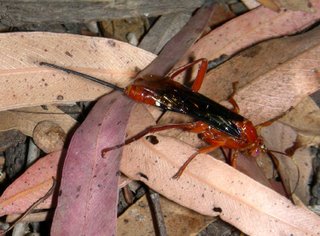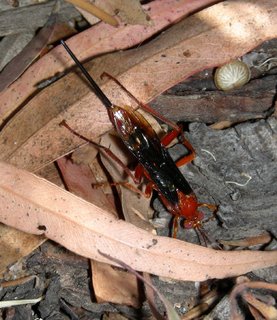 I spotted this wasp in a garden bed at work. It's either an ichneumon or a braconid. (I'm still not up to speed on wasp systematics but maybe Amegilla can narrow it down.) Either way, it's a parasitoid, one of those wasps with the grisly and fascinating life cycles.
I spotted this wasp in a garden bed at work. It's either an ichneumon or a braconid. (I'm still not up to speed on wasp systematics but maybe Amegilla can narrow it down.) Either way, it's a parasitoid, one of those wasps with the grisly and fascinating life cycles.The female lays her eggs on or in the host, using the long ovipositor to position them just so. The host remains alive, which means that the larva is living in a larder that never runs out of fresh food.
 These wasps have several interesting adaptations. There's that whopping great big ovipositor—the hypodermic needle at the rear end—which penetrates the host's exoskeleton and deposits the eggs with surgical accuracy. And the underside of the abdomen is less heavily armoured than in other types of wasps, so it is extremely flexible. This helps in egg-laying. For a similar reason, the legs also have an extra joint, so the wasp can raise its body high over the host.
These wasps have several interesting adaptations. There's that whopping great big ovipositor—the hypodermic needle at the rear end—which penetrates the host's exoskeleton and deposits the eggs with surgical accuracy. And the underside of the abdomen is less heavily armoured than in other types of wasps, so it is extremely flexible. This helps in egg-laying. For a similar reason, the legs also have an extra joint, so the wasp can raise its body high over the host.They 'parasitise' a wide range of species and are not above attacking their cousins, the sawflies.
Ha! Alien schmalien.